The Impact of Language and Canadian Culture on Immigrants: A Report
VerifiedAdded on 2022/05/23
|20
|4946
|23
Report
AI Summary
This report, prepared for Comm 3013, analyzes the impact of language and Canadian culture on immigrants. It explores challenges such as the fear of speaking a new language and cultural differences, including religious diversity and hospitality. The report provides practical remedies for overcoming language barriers, such as improving listening skills and controlling conversation speed, while also examining how age influences cultural adaptation. It highlights the importance of understanding Canadian secularism and the diverse religious landscape. The research incorporates formal research techniques and offers recommendations for immigrants to integrate into Canadian society, with a focus on fostering peace and understanding. The report emphasizes the importance of overcoming anxiety, improving listening skills, and controlling the pace of conversation to ease the process of adaptation. The report also provides an overview of Canadian religious diversity and how immigrants can navigate the cultural landscape.
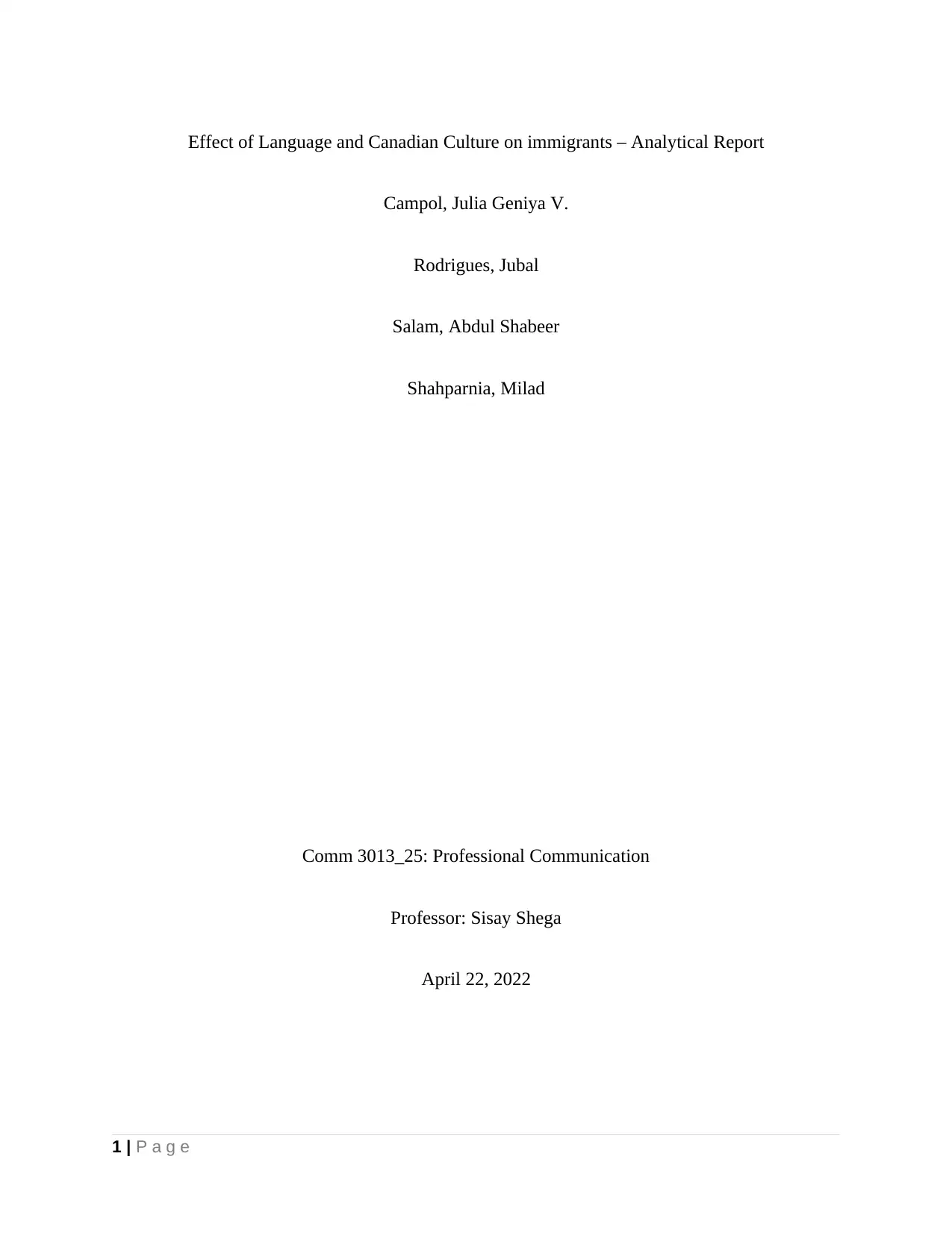
Effect of Language and Canadian Culture on immigrants – Analytical Report
Campol, Julia Geniya V.
Rodrigues, Jubal
Salam, Abdul Shabeer
Shahparnia, Milad
Comm 3013_25: Professional Communication
Professor: Sisay Shega
April 22, 2022
1 | P a g e
Campol, Julia Geniya V.
Rodrigues, Jubal
Salam, Abdul Shabeer
Shahparnia, Milad
Comm 3013_25: Professional Communication
Professor: Sisay Shega
April 22, 2022
1 | P a g e
Paraphrase This Document
Need a fresh take? Get an instant paraphrase of this document with our AI Paraphraser
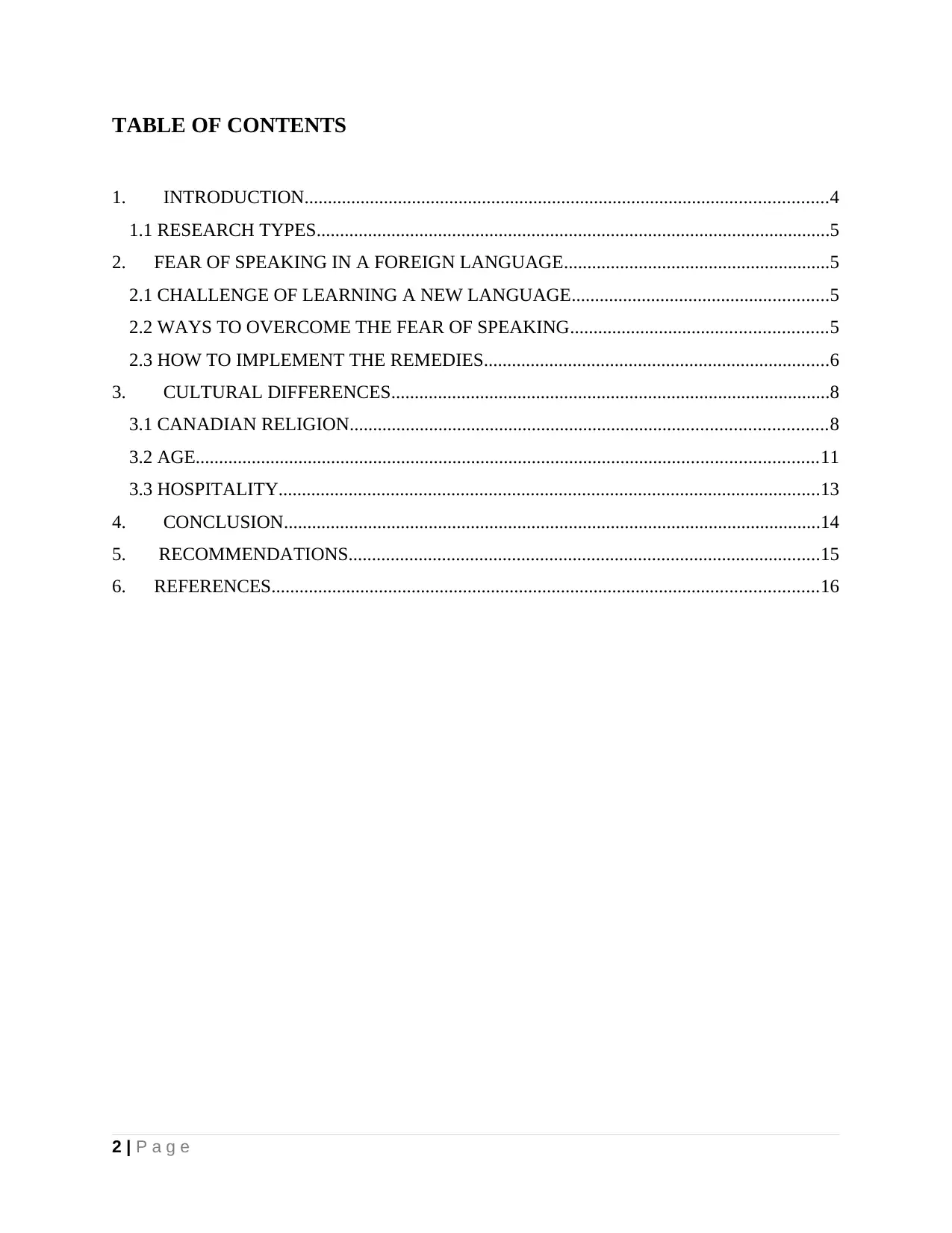
TABLE OF CONTENTS
1. INTRODUCTION................................................................................................................4
1.1 RESEARCH TYPES..............................................................................................................5
2. FEAR OF SPEAKING IN A FOREIGN LANGUAGE.........................................................5
2.1 CHALLENGE OF LEARNING A NEW LANGUAGE.......................................................5
2.2 WAYS TO OVERCOME THE FEAR OF SPEAKING.......................................................5
2.3 HOW TO IMPLEMENT THE REMEDIES..........................................................................6
3. CULTURAL DIFFERENCES..............................................................................................8
3.1 CANADIAN RELIGION......................................................................................................8
3.2 AGE.....................................................................................................................................11
3.3 HOSPITALITY....................................................................................................................13
4. CONCLUSION...................................................................................................................14
5. RECOMMENDATIONS.....................................................................................................15
6. REFERENCES.....................................................................................................................16
2 | P a g e
1. INTRODUCTION................................................................................................................4
1.1 RESEARCH TYPES..............................................................................................................5
2. FEAR OF SPEAKING IN A FOREIGN LANGUAGE.........................................................5
2.1 CHALLENGE OF LEARNING A NEW LANGUAGE.......................................................5
2.2 WAYS TO OVERCOME THE FEAR OF SPEAKING.......................................................5
2.3 HOW TO IMPLEMENT THE REMEDIES..........................................................................6
3. CULTURAL DIFFERENCES..............................................................................................8
3.1 CANADIAN RELIGION......................................................................................................8
3.2 AGE.....................................................................................................................................11
3.3 HOSPITALITY....................................................................................................................13
4. CONCLUSION...................................................................................................................14
5. RECOMMENDATIONS.....................................................................................................15
6. REFERENCES.....................................................................................................................16
2 | P a g e
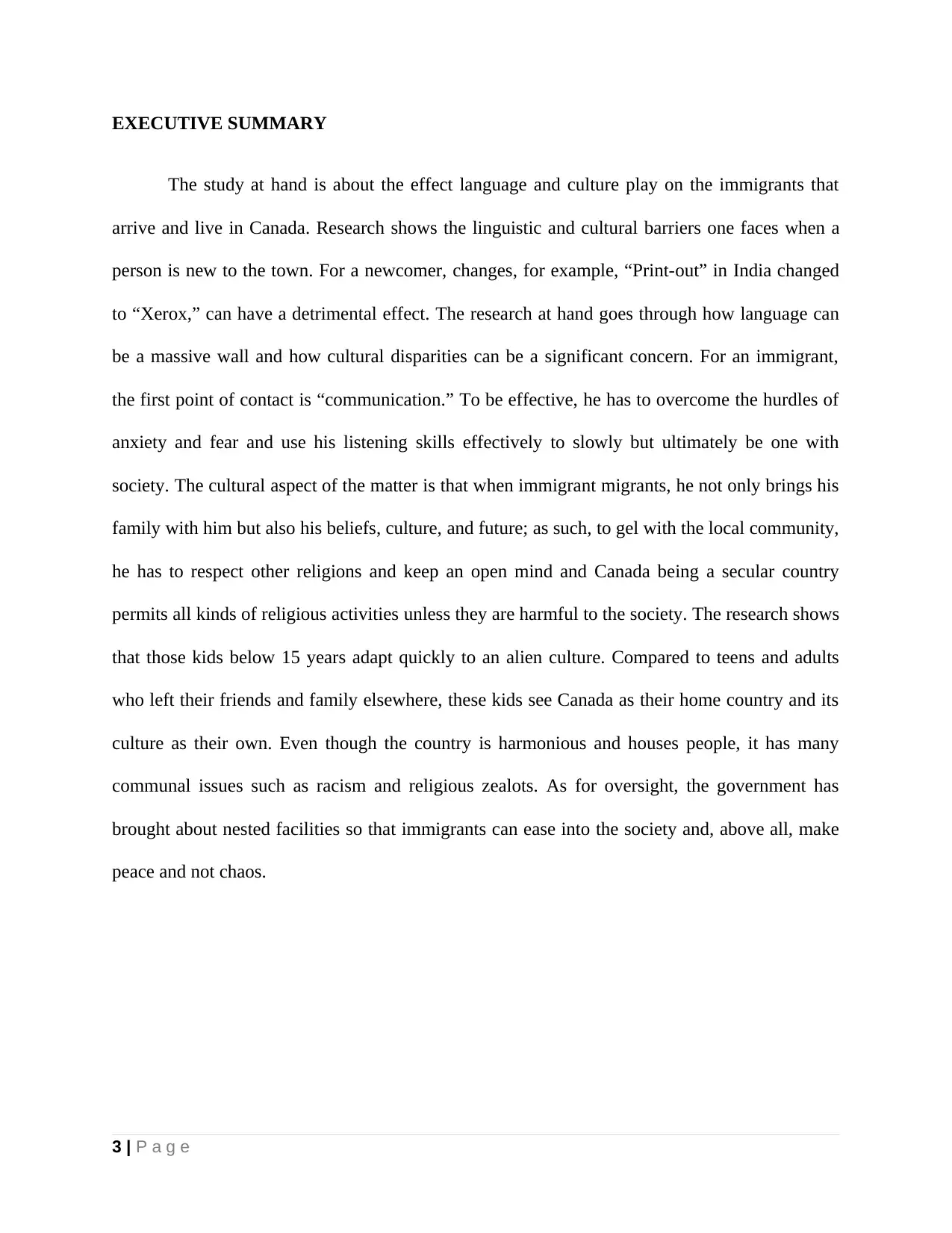
EXECUTIVE SUMMARY
The study at hand is about the effect language and culture play on the immigrants that
arrive and live in Canada. Research shows the linguistic and cultural barriers one faces when a
person is new to the town. For a newcomer, changes, for example, “Print-out” in India changed
to “Xerox,” can have a detrimental effect. The research at hand goes through how language can
be a massive wall and how cultural disparities can be a significant concern. For an immigrant,
the first point of contact is “communication.” To be effective, he has to overcome the hurdles of
anxiety and fear and use his listening skills effectively to slowly but ultimately be one with
society. The cultural aspect of the matter is that when immigrant migrants, he not only brings his
family with him but also his beliefs, culture, and future; as such, to gel with the local community,
he has to respect other religions and keep an open mind and Canada being a secular country
permits all kinds of religious activities unless they are harmful to the society. The research shows
that those kids below 15 years adapt quickly to an alien culture. Compared to teens and adults
who left their friends and family elsewhere, these kids see Canada as their home country and its
culture as their own. Even though the country is harmonious and houses people, it has many
communal issues such as racism and religious zealots. As for oversight, the government has
brought about nested facilities so that immigrants can ease into the society and, above all, make
peace and not chaos.
3 | P a g e
The study at hand is about the effect language and culture play on the immigrants that
arrive and live in Canada. Research shows the linguistic and cultural barriers one faces when a
person is new to the town. For a newcomer, changes, for example, “Print-out” in India changed
to “Xerox,” can have a detrimental effect. The research at hand goes through how language can
be a massive wall and how cultural disparities can be a significant concern. For an immigrant,
the first point of contact is “communication.” To be effective, he has to overcome the hurdles of
anxiety and fear and use his listening skills effectively to slowly but ultimately be one with
society. The cultural aspect of the matter is that when immigrant migrants, he not only brings his
family with him but also his beliefs, culture, and future; as such, to gel with the local community,
he has to respect other religions and keep an open mind and Canada being a secular country
permits all kinds of religious activities unless they are harmful to the society. The research shows
that those kids below 15 years adapt quickly to an alien culture. Compared to teens and adults
who left their friends and family elsewhere, these kids see Canada as their home country and its
culture as their own. Even though the country is harmonious and houses people, it has many
communal issues such as racism and religious zealots. As for oversight, the government has
brought about nested facilities so that immigrants can ease into the society and, above all, make
peace and not chaos.
3 | P a g e
⊘ This is a preview!⊘
Do you want full access?
Subscribe today to unlock all pages.

Trusted by 1+ million students worldwide
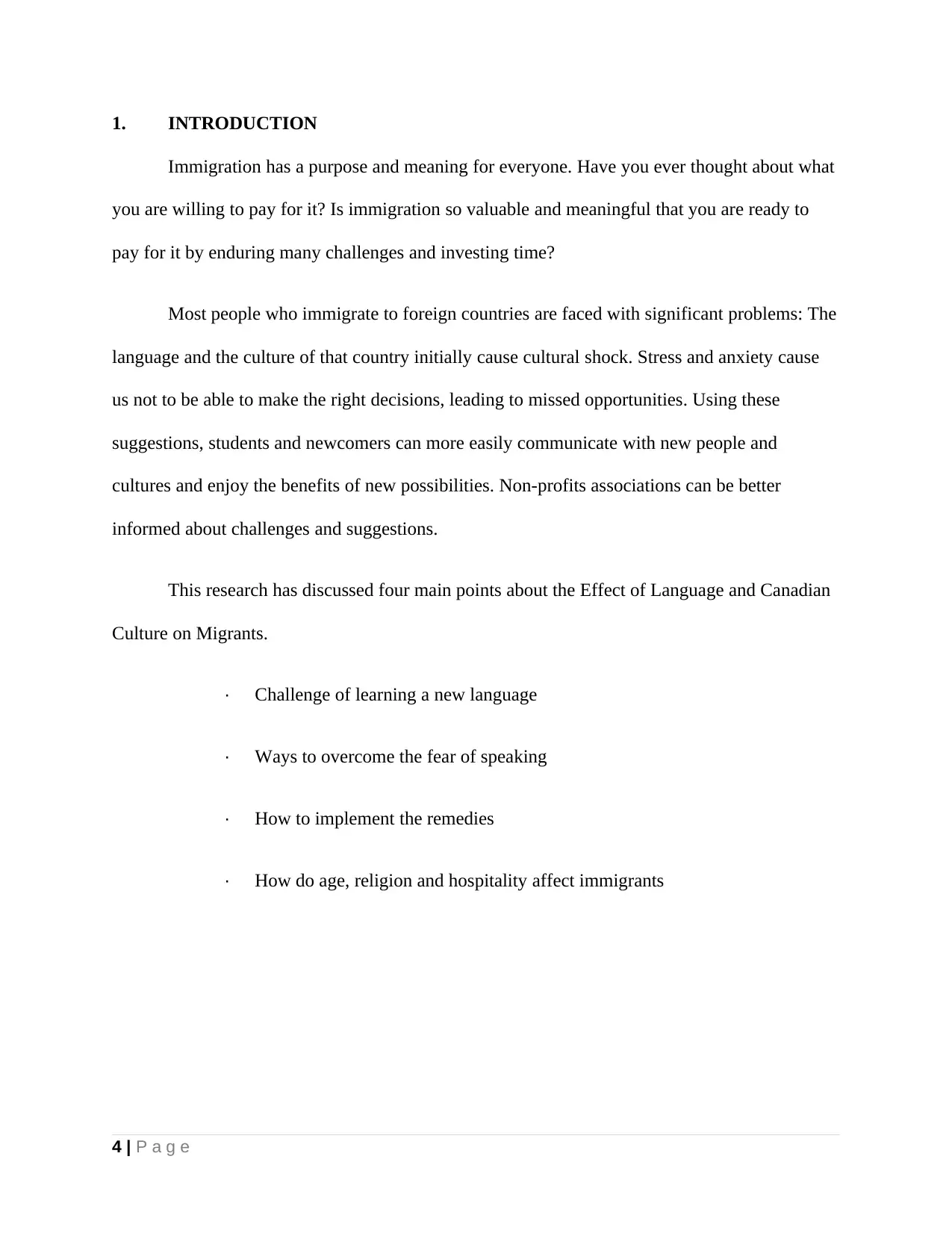
1. INTRODUCTION
Immigration has a purpose and meaning for everyone. Have you ever thought about what
you are willing to pay for it? Is immigration so valuable and meaningful that you are ready to
pay for it by enduring many challenges and investing time?
Most people who immigrate to foreign countries are faced with significant problems: The
language and the culture of that country initially cause cultural shock. Stress and anxiety cause
us not to be able to make the right decisions, leading to missed opportunities. Using these
suggestions, students and newcomers can more easily communicate with new people and
cultures and enjoy the benefits of new possibilities. Non-profits associations can be better
informed about challenges and suggestions.
This research has discussed four main points about the Effect of Language and Canadian
Culture on Migrants.
· Challenge of learning a new language
· Ways to overcome the fear of speaking
· How to implement the remedies
· How do age, religion and hospitality affect immigrants
4 | P a g e
Immigration has a purpose and meaning for everyone. Have you ever thought about what
you are willing to pay for it? Is immigration so valuable and meaningful that you are ready to
pay for it by enduring many challenges and investing time?
Most people who immigrate to foreign countries are faced with significant problems: The
language and the culture of that country initially cause cultural shock. Stress and anxiety cause
us not to be able to make the right decisions, leading to missed opportunities. Using these
suggestions, students and newcomers can more easily communicate with new people and
cultures and enjoy the benefits of new possibilities. Non-profits associations can be better
informed about challenges and suggestions.
This research has discussed four main points about the Effect of Language and Canadian
Culture on Migrants.
· Challenge of learning a new language
· Ways to overcome the fear of speaking
· How to implement the remedies
· How do age, religion and hospitality affect immigrants
4 | P a g e
Paraphrase This Document
Need a fresh take? Get an instant paraphrase of this document with our AI Paraphraser
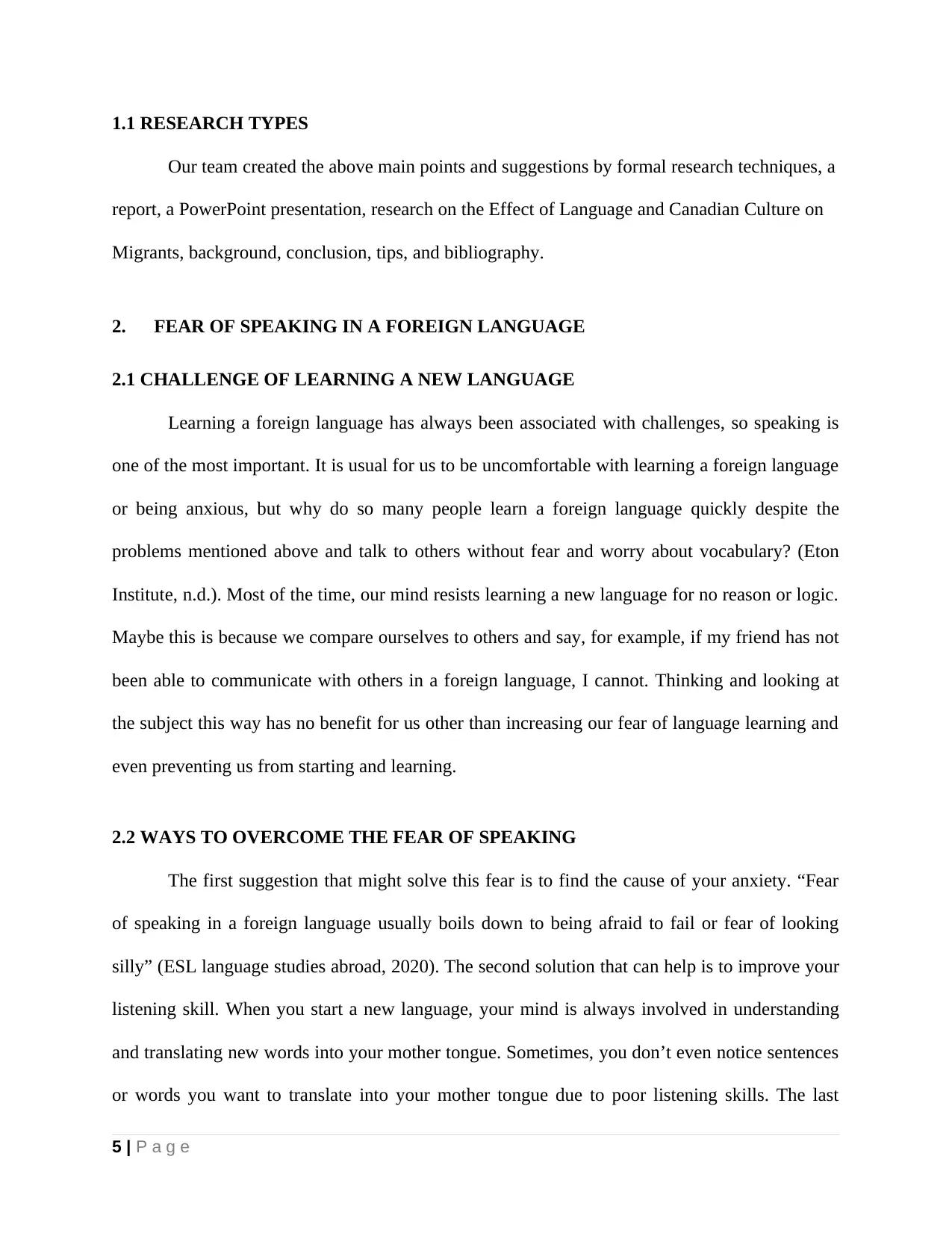
1.1 RESEARCH TYPES
Our team created the above main points and suggestions by formal research techniques, a
report, a PowerPoint presentation, research on the Effect of Language and Canadian Culture on
Migrants, background, conclusion, tips, and bibliography.
2. FEAR OF SPEAKING IN A FOREIGN LANGUAGE
2.1 CHALLENGE OF LEARNING A NEW LANGUAGE
Learning a foreign language has always been associated with challenges, so speaking is
one of the most important. It is usual for us to be uncomfortable with learning a foreign language
or being anxious, but why do so many people learn a foreign language quickly despite the
problems mentioned above and talk to others without fear and worry about vocabulary? (Eton
Institute, n.d.). Most of the time, our mind resists learning a new language for no reason or logic.
Maybe this is because we compare ourselves to others and say, for example, if my friend has not
been able to communicate with others in a foreign language, I cannot. Thinking and looking at
the subject this way has no benefit for us other than increasing our fear of language learning and
even preventing us from starting and learning.
2.2 WAYS TO OVERCOME THE FEAR OF SPEAKING
The first suggestion that might solve this fear is to find the cause of your anxiety. “Fear
of speaking in a foreign language usually boils down to being afraid to fail or fear of looking
silly” (ESL language studies abroad, 2020). The second solution that can help is to improve your
listening skill. When you start a new language, your mind is always involved in understanding
and translating new words into your mother tongue. Sometimes, you don’t even notice sentences
or words you want to translate into your mother tongue due to poor listening skills. The last
5 | P a g e
Our team created the above main points and suggestions by formal research techniques, a
report, a PowerPoint presentation, research on the Effect of Language and Canadian Culture on
Migrants, background, conclusion, tips, and bibliography.
2. FEAR OF SPEAKING IN A FOREIGN LANGUAGE
2.1 CHALLENGE OF LEARNING A NEW LANGUAGE
Learning a foreign language has always been associated with challenges, so speaking is
one of the most important. It is usual for us to be uncomfortable with learning a foreign language
or being anxious, but why do so many people learn a foreign language quickly despite the
problems mentioned above and talk to others without fear and worry about vocabulary? (Eton
Institute, n.d.). Most of the time, our mind resists learning a new language for no reason or logic.
Maybe this is because we compare ourselves to others and say, for example, if my friend has not
been able to communicate with others in a foreign language, I cannot. Thinking and looking at
the subject this way has no benefit for us other than increasing our fear of language learning and
even preventing us from starting and learning.
2.2 WAYS TO OVERCOME THE FEAR OF SPEAKING
The first suggestion that might solve this fear is to find the cause of your anxiety. “Fear
of speaking in a foreign language usually boils down to being afraid to fail or fear of looking
silly” (ESL language studies abroad, 2020). The second solution that can help is to improve your
listening skill. When you start a new language, your mind is always involved in understanding
and translating new words into your mother tongue. Sometimes, you don’t even notice sentences
or words you want to translate into your mother tongue due to poor listening skills. The last
5 | P a g e
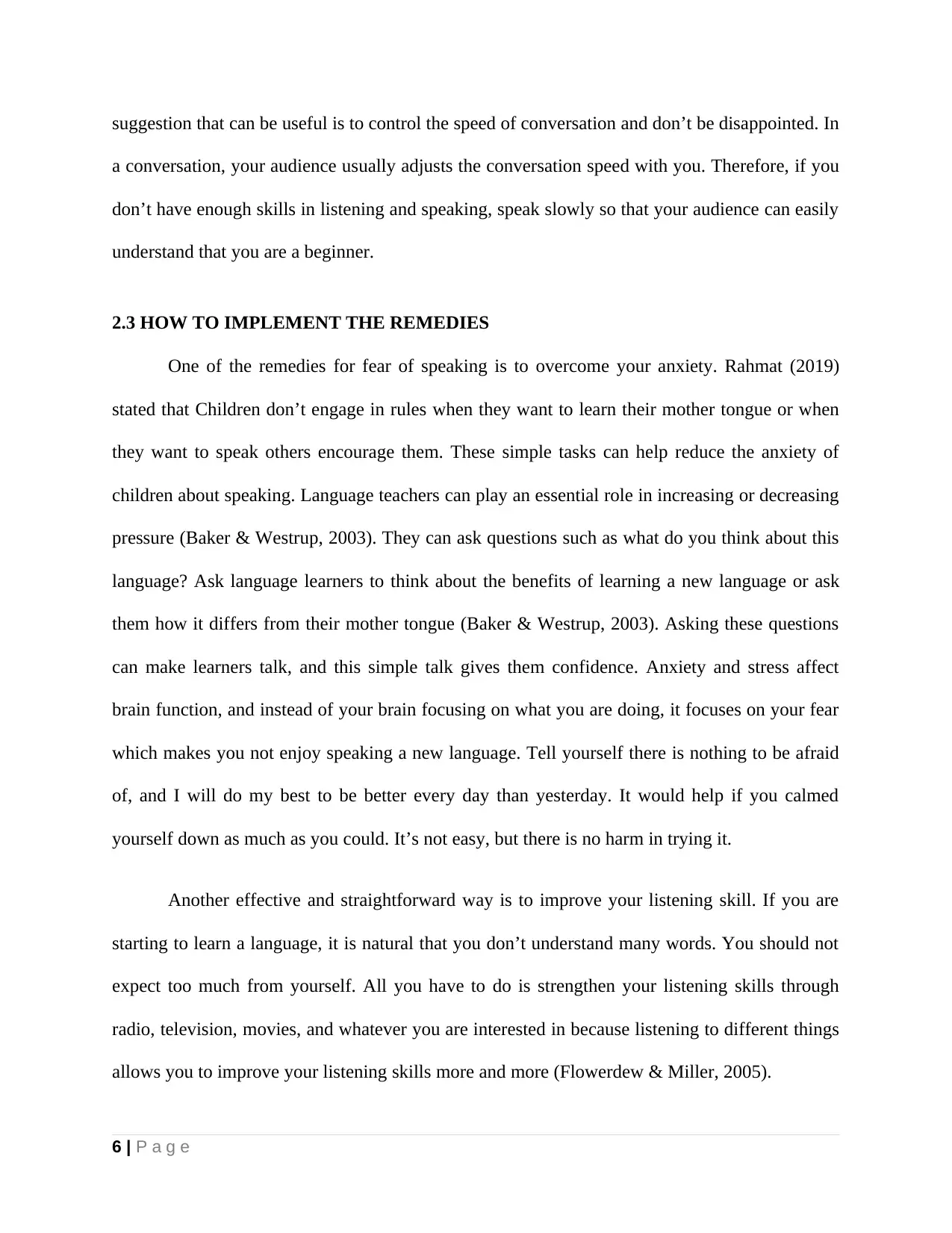
suggestion that can be useful is to control the speed of conversation and don’t be disappointed. In
a conversation, your audience usually adjusts the conversation speed with you. Therefore, if you
don’t have enough skills in listening and speaking, speak slowly so that your audience can easily
understand that you are a beginner.
2.3 HOW TO IMPLEMENT THE REMEDIES
One of the remedies for fear of speaking is to overcome your anxiety. Rahmat (2019)
stated that Children don’t engage in rules when they want to learn their mother tongue or when
they want to speak others encourage them. These simple tasks can help reduce the anxiety of
children about speaking. Language teachers can play an essential role in increasing or decreasing
pressure (Baker & Westrup, 2003). They can ask questions such as what do you think about this
language? Ask language learners to think about the benefits of learning a new language or ask
them how it differs from their mother tongue (Baker & Westrup, 2003). Asking these questions
can make learners talk, and this simple talk gives them confidence. Anxiety and stress affect
brain function, and instead of your brain focusing on what you are doing, it focuses on your fear
which makes you not enjoy speaking a new language. Tell yourself there is nothing to be afraid
of, and I will do my best to be better every day than yesterday. It would help if you calmed
yourself down as much as you could. It’s not easy, but there is no harm in trying it.
Another effective and straightforward way is to improve your listening skill. If you are
starting to learn a language, it is natural that you don’t understand many words. You should not
expect too much from yourself. All you have to do is strengthen your listening skills through
radio, television, movies, and whatever you are interested in because listening to different things
allows you to improve your listening skills more and more (Flowerdew & Miller, 2005).
6 | P a g e
a conversation, your audience usually adjusts the conversation speed with you. Therefore, if you
don’t have enough skills in listening and speaking, speak slowly so that your audience can easily
understand that you are a beginner.
2.3 HOW TO IMPLEMENT THE REMEDIES
One of the remedies for fear of speaking is to overcome your anxiety. Rahmat (2019)
stated that Children don’t engage in rules when they want to learn their mother tongue or when
they want to speak others encourage them. These simple tasks can help reduce the anxiety of
children about speaking. Language teachers can play an essential role in increasing or decreasing
pressure (Baker & Westrup, 2003). They can ask questions such as what do you think about this
language? Ask language learners to think about the benefits of learning a new language or ask
them how it differs from their mother tongue (Baker & Westrup, 2003). Asking these questions
can make learners talk, and this simple talk gives them confidence. Anxiety and stress affect
brain function, and instead of your brain focusing on what you are doing, it focuses on your fear
which makes you not enjoy speaking a new language. Tell yourself there is nothing to be afraid
of, and I will do my best to be better every day than yesterday. It would help if you calmed
yourself down as much as you could. It’s not easy, but there is no harm in trying it.
Another effective and straightforward way is to improve your listening skill. If you are
starting to learn a language, it is natural that you don’t understand many words. You should not
expect too much from yourself. All you have to do is strengthen your listening skills through
radio, television, movies, and whatever you are interested in because listening to different things
allows you to improve your listening skills more and more (Flowerdew & Miller, 2005).
6 | P a g e
⊘ This is a preview!⊘
Do you want full access?
Subscribe today to unlock all pages.

Trusted by 1+ million students worldwide
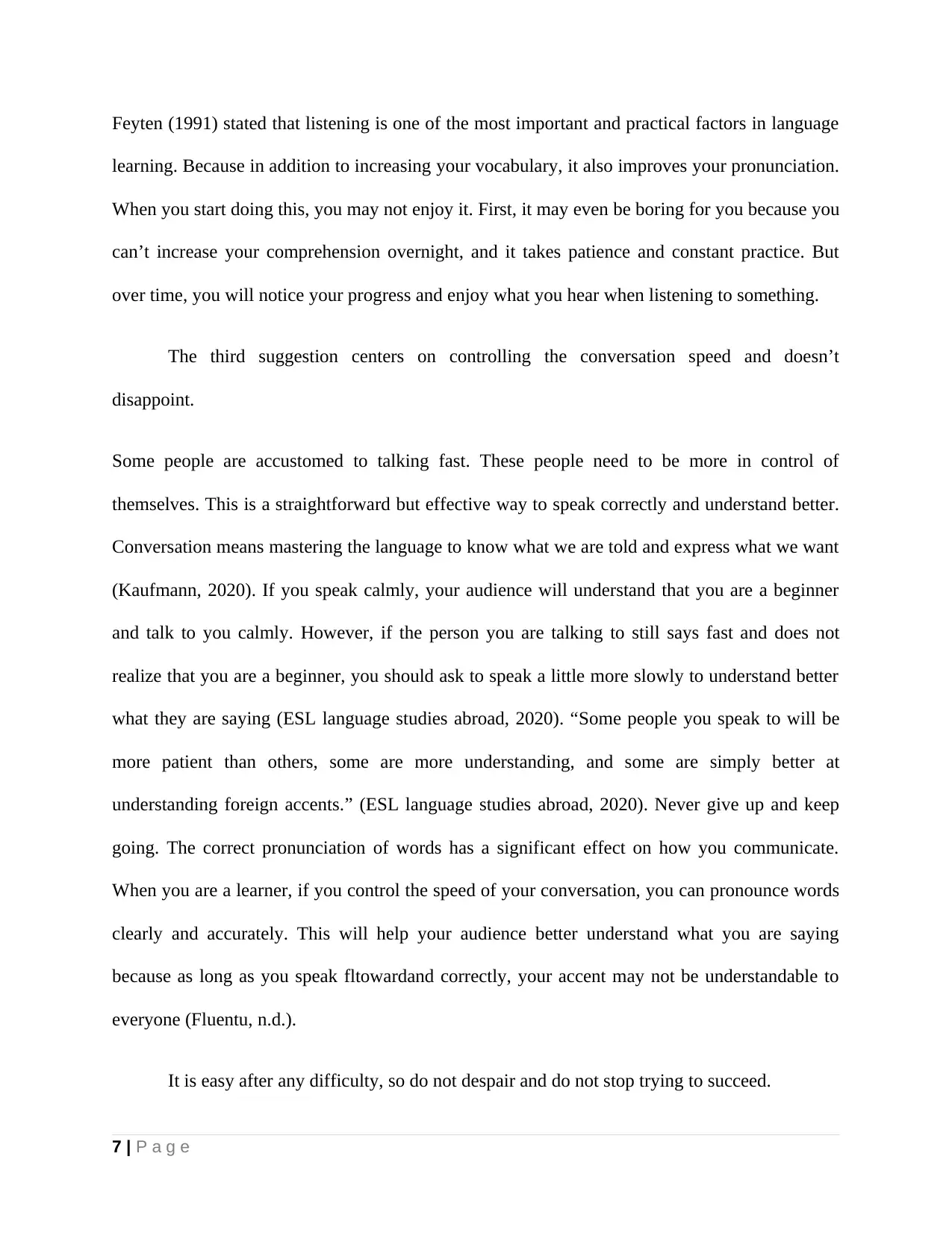
Feyten (1991) stated that listening is one of the most important and practical factors in language
learning. Because in addition to increasing your vocabulary, it also improves your pronunciation.
When you start doing this, you may not enjoy it. First, it may even be boring for you because you
can’t increase your comprehension overnight, and it takes patience and constant practice. But
over time, you will notice your progress and enjoy what you hear when listening to something.
The third suggestion centers on controlling the conversation speed and doesn’t
disappoint.
Some people are accustomed to talking fast. These people need to be more in control of
themselves. This is a straightforward but effective way to speak correctly and understand better.
Conversation means mastering the language to know what we are told and express what we want
(Kaufmann, 2020). If you speak calmly, your audience will understand that you are a beginner
and talk to you calmly. However, if the person you are talking to still says fast and does not
realize that you are a beginner, you should ask to speak a little more slowly to understand better
what they are saying (ESL language studies abroad, 2020). “Some people you speak to will be
more patient than others, some are more understanding, and some are simply better at
understanding foreign accents.” (ESL language studies abroad, 2020). Never give up and keep
going. The correct pronunciation of words has a significant effect on how you communicate.
When you are a learner, if you control the speed of your conversation, you can pronounce words
clearly and accurately. This will help your audience better understand what you are saying
because as long as you speak fltowardand correctly, your accent may not be understandable to
everyone (Fluentu, n.d.).
It is easy after any difficulty, so do not despair and do not stop trying to succeed.
7 | P a g e
learning. Because in addition to increasing your vocabulary, it also improves your pronunciation.
When you start doing this, you may not enjoy it. First, it may even be boring for you because you
can’t increase your comprehension overnight, and it takes patience and constant practice. But
over time, you will notice your progress and enjoy what you hear when listening to something.
The third suggestion centers on controlling the conversation speed and doesn’t
disappoint.
Some people are accustomed to talking fast. These people need to be more in control of
themselves. This is a straightforward but effective way to speak correctly and understand better.
Conversation means mastering the language to know what we are told and express what we want
(Kaufmann, 2020). If you speak calmly, your audience will understand that you are a beginner
and talk to you calmly. However, if the person you are talking to still says fast and does not
realize that you are a beginner, you should ask to speak a little more slowly to understand better
what they are saying (ESL language studies abroad, 2020). “Some people you speak to will be
more patient than others, some are more understanding, and some are simply better at
understanding foreign accents.” (ESL language studies abroad, 2020). Never give up and keep
going. The correct pronunciation of words has a significant effect on how you communicate.
When you are a learner, if you control the speed of your conversation, you can pronounce words
clearly and accurately. This will help your audience better understand what you are saying
because as long as you speak fltowardand correctly, your accent may not be understandable to
everyone (Fluentu, n.d.).
It is easy after any difficulty, so do not despair and do not stop trying to succeed.
7 | P a g e
Paraphrase This Document
Need a fresh take? Get an instant paraphrase of this document with our AI Paraphraser
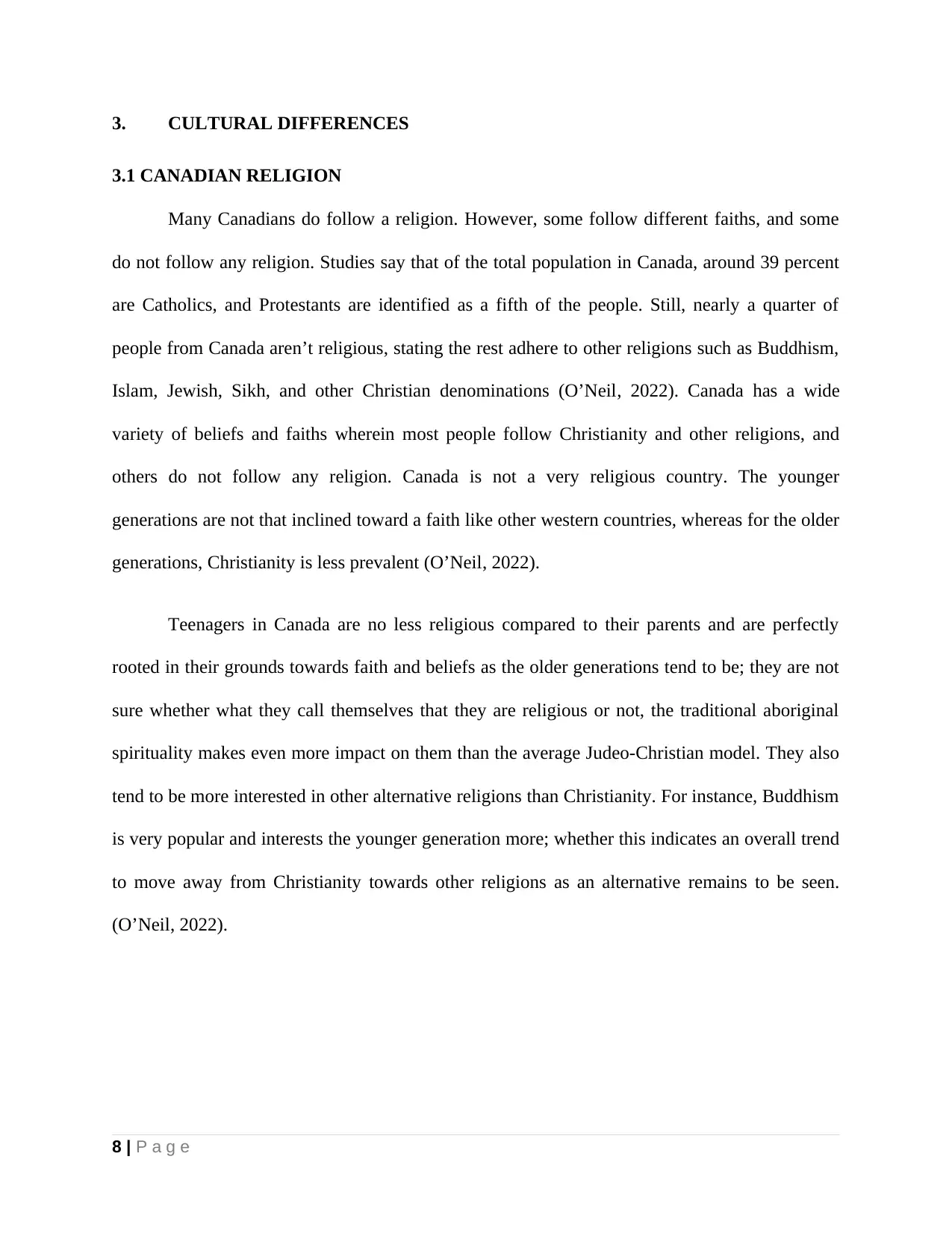
3. CULTURAL DIFFERENCES
3.1 CANADIAN RELIGION
Many Canadians do follow a religion. However, some follow different faiths, and some
do not follow any religion. Studies say that of the total population in Canada, around 39 percent
are Catholics, and Protestants are identified as a fifth of the people. Still, nearly a quarter of
people from Canada aren’t religious, stating the rest adhere to other religions such as Buddhism,
Islam, Jewish, Sikh, and other Christian denominations (O’Neil, 2022). Canada has a wide
variety of beliefs and faiths wherein most people follow Christianity and other religions, and
others do not follow any religion. Canada is not a very religious country. The younger
generations are not that inclined toward a faith like other western countries, whereas for the older
generations, Christianity is less prevalent (O’Neil, 2022).
Teenagers in Canada are no less religious compared to their parents and are perfectly
rooted in their grounds towards faith and beliefs as the older generations tend to be; they are not
sure whether what they call themselves that they are religious or not, the traditional aboriginal
spirituality makes even more impact on them than the average Judeo-Christian model. They also
tend to be more interested in other alternative religions than Christianity. For instance, Buddhism
is very popular and interests the younger generation more; whether this indicates an overall trend
to move away from Christianity towards other religions as an alternative remains to be seen.
(O’Neil, 2022).
8 | P a g e
3.1 CANADIAN RELIGION
Many Canadians do follow a religion. However, some follow different faiths, and some
do not follow any religion. Studies say that of the total population in Canada, around 39 percent
are Catholics, and Protestants are identified as a fifth of the people. Still, nearly a quarter of
people from Canada aren’t religious, stating the rest adhere to other religions such as Buddhism,
Islam, Jewish, Sikh, and other Christian denominations (O’Neil, 2022). Canada has a wide
variety of beliefs and faiths wherein most people follow Christianity and other religions, and
others do not follow any religion. Canada is not a very religious country. The younger
generations are not that inclined toward a faith like other western countries, whereas for the older
generations, Christianity is less prevalent (O’Neil, 2022).
Teenagers in Canada are no less religious compared to their parents and are perfectly
rooted in their grounds towards faith and beliefs as the older generations tend to be; they are not
sure whether what they call themselves that they are religious or not, the traditional aboriginal
spirituality makes even more impact on them than the average Judeo-Christian model. They also
tend to be more interested in other alternative religions than Christianity. For instance, Buddhism
is very popular and interests the younger generation more; whether this indicates an overall trend
to move away from Christianity towards other religions as an alternative remains to be seen.
(O’Neil, 2022).
8 | P a g e
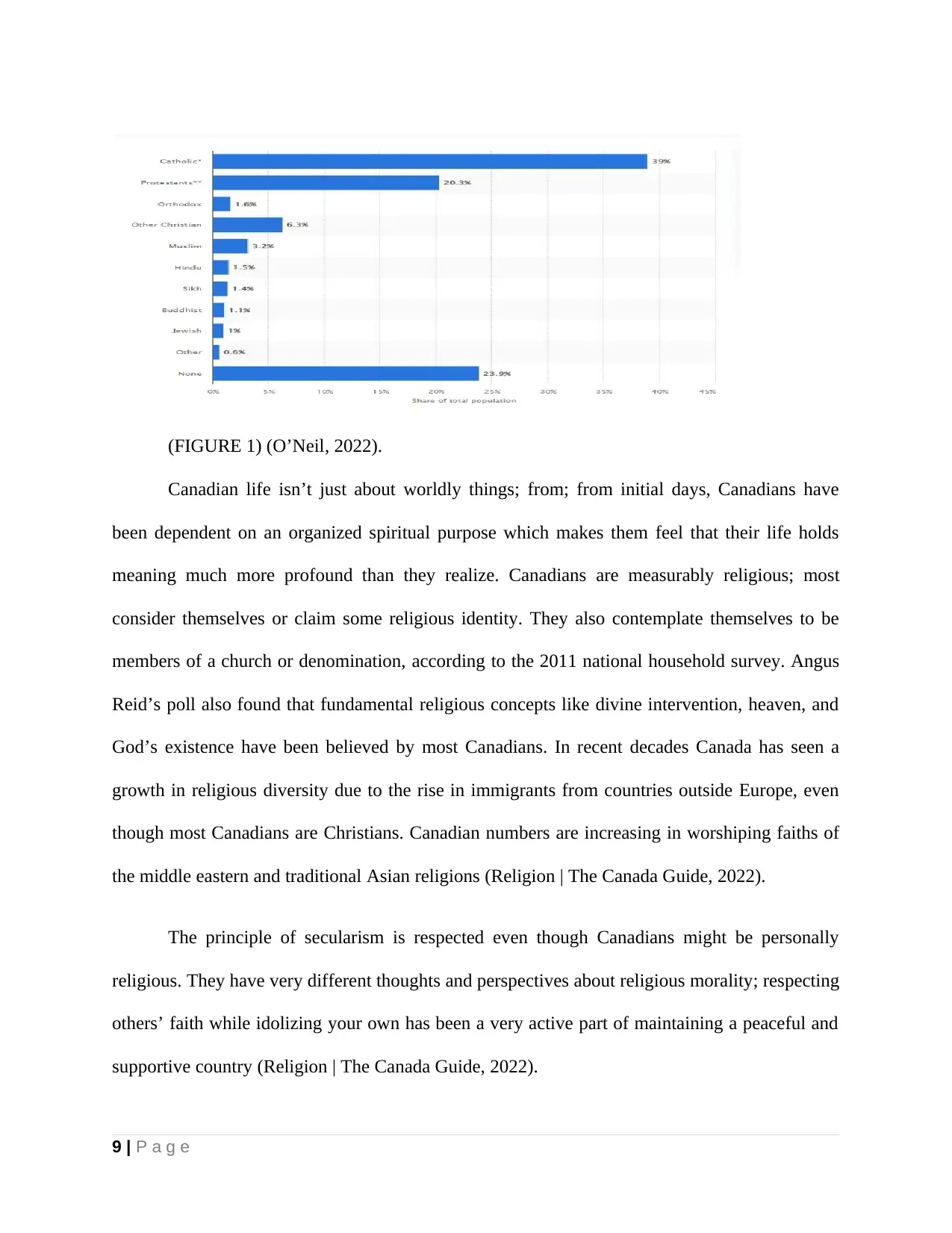
(FIGURE 1) (O’Neil, 2022).
Canadian life isn’t just about worldly things; from; from initial days, Canadians have
been dependent on an organized spiritual purpose which makes them feel that their life holds
meaning much more profound than they realize. Canadians are measurably religious; most
consider themselves or claim some religious identity. They also contemplate themselves to be
members of a church or denomination, according to the 2011 national household survey. Angus
Reid’s poll also found that fundamental religious concepts like divine intervention, heaven, and
God’s existence have been believed by most Canadians. In recent decades Canada has seen a
growth in religious diversity due to the rise in immigrants from countries outside Europe, even
though most Canadians are Christians. Canadian numbers are increasing in worshiping faiths of
the middle eastern and traditional Asian religions (Religion | The Canada Guide, 2022).
The principle of secularism is respected even though Canadians might be personally
religious. They have very different thoughts and perspectives about religious morality; respecting
others’ faith while idolizing your own has been a very active part of maintaining a peaceful and
supportive country (Religion | The Canada Guide, 2022).
9 | P a g e
Canadian life isn’t just about worldly things; from; from initial days, Canadians have
been dependent on an organized spiritual purpose which makes them feel that their life holds
meaning much more profound than they realize. Canadians are measurably religious; most
consider themselves or claim some religious identity. They also contemplate themselves to be
members of a church or denomination, according to the 2011 national household survey. Angus
Reid’s poll also found that fundamental religious concepts like divine intervention, heaven, and
God’s existence have been believed by most Canadians. In recent decades Canada has seen a
growth in religious diversity due to the rise in immigrants from countries outside Europe, even
though most Canadians are Christians. Canadian numbers are increasing in worshiping faiths of
the middle eastern and traditional Asian religions (Religion | The Canada Guide, 2022).
The principle of secularism is respected even though Canadians might be personally
religious. They have very different thoughts and perspectives about religious morality; respecting
others’ faith while idolizing your own has been a very active part of maintaining a peaceful and
supportive country (Religion | The Canada Guide, 2022).
9 | P a g e
⊘ This is a preview!⊘
Do you want full access?
Subscribe today to unlock all pages.

Trusted by 1+ million students worldwide
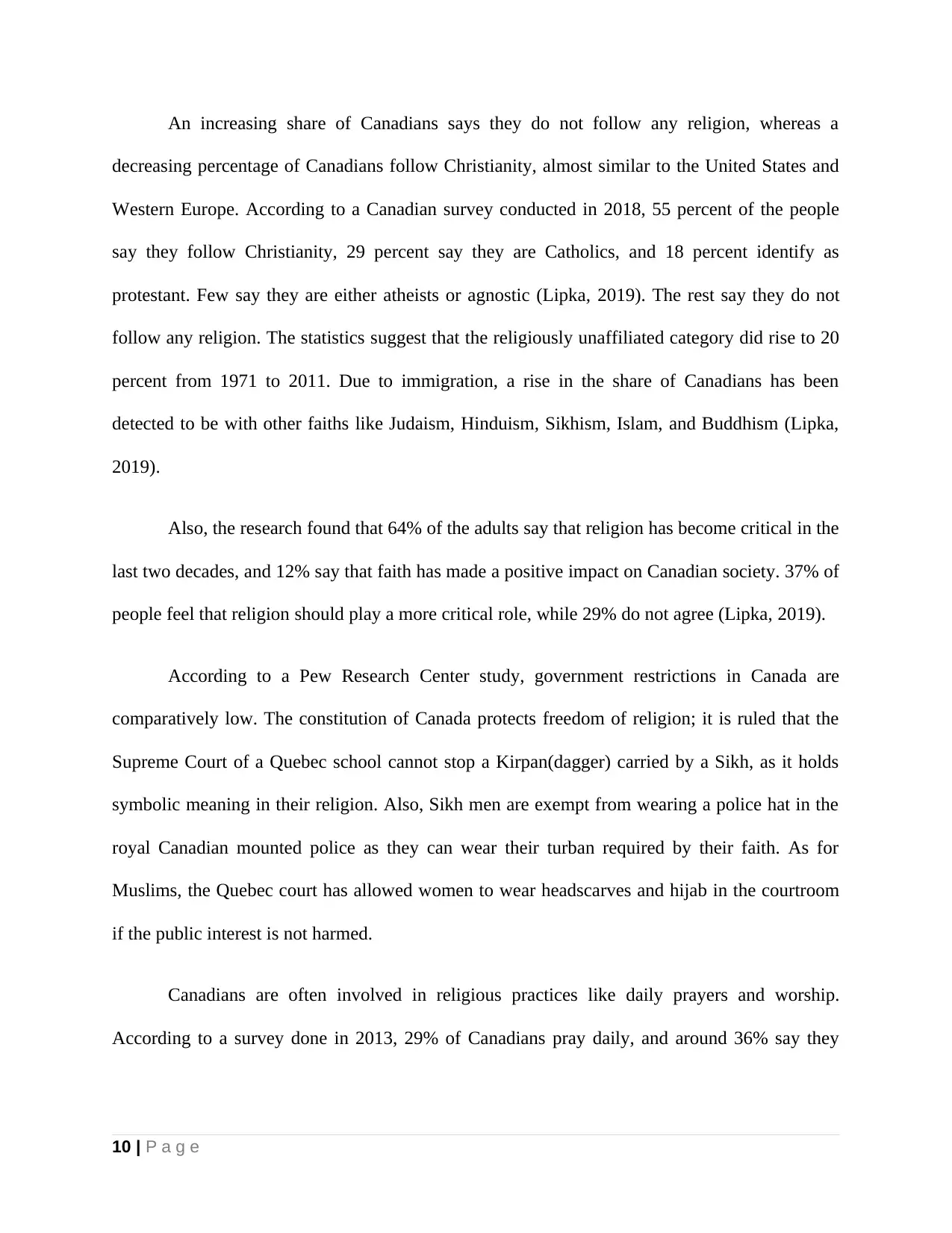
An increasing share of Canadians says they do not follow any religion, whereas a
decreasing percentage of Canadians follow Christianity, almost similar to the United States and
Western Europe. According to a Canadian survey conducted in 2018, 55 percent of the people
say they follow Christianity, 29 percent say they are Catholics, and 18 percent identify as
protestant. Few say they are either atheists or agnostic (Lipka, 2019). The rest say they do not
follow any religion. The statistics suggest that the religiously unaffiliated category did rise to 20
percent from 1971 to 2011. Due to immigration, a rise in the share of Canadians has been
detected to be with other faiths like Judaism, Hinduism, Sikhism, Islam, and Buddhism (Lipka,
2019).
Also, the research found that 64% of the adults say that religion has become critical in the
last two decades, and 12% say that faith has made a positive impact on Canadian society. 37% of
people feel that religion should play a more critical role, while 29% do not agree (Lipka, 2019).
According to a Pew Research Center study, government restrictions in Canada are
comparatively low. The constitution of Canada protects freedom of religion; it is ruled that the
Supreme Court of a Quebec school cannot stop a Kirpan(dagger) carried by a Sikh, as it holds
symbolic meaning in their religion. Also, Sikh men are exempt from wearing a police hat in the
royal Canadian mounted police as they can wear their turban required by their faith. As for
Muslims, the Quebec court has allowed women to wear headscarves and hijab in the courtroom
if the public interest is not harmed.
Canadians are often involved in religious practices like daily prayers and worship.
According to a survey done in 2013, 29% of Canadians pray daily, and around 36% say they
10 | P a g e
decreasing percentage of Canadians follow Christianity, almost similar to the United States and
Western Europe. According to a Canadian survey conducted in 2018, 55 percent of the people
say they follow Christianity, 29 percent say they are Catholics, and 18 percent identify as
protestant. Few say they are either atheists or agnostic (Lipka, 2019). The rest say they do not
follow any religion. The statistics suggest that the religiously unaffiliated category did rise to 20
percent from 1971 to 2011. Due to immigration, a rise in the share of Canadians has been
detected to be with other faiths like Judaism, Hinduism, Sikhism, Islam, and Buddhism (Lipka,
2019).
Also, the research found that 64% of the adults say that religion has become critical in the
last two decades, and 12% say that faith has made a positive impact on Canadian society. 37% of
people feel that religion should play a more critical role, while 29% do not agree (Lipka, 2019).
According to a Pew Research Center study, government restrictions in Canada are
comparatively low. The constitution of Canada protects freedom of religion; it is ruled that the
Supreme Court of a Quebec school cannot stop a Kirpan(dagger) carried by a Sikh, as it holds
symbolic meaning in their religion. Also, Sikh men are exempt from wearing a police hat in the
royal Canadian mounted police as they can wear their turban required by their faith. As for
Muslims, the Quebec court has allowed women to wear headscarves and hijab in the courtroom
if the public interest is not harmed.
Canadians are often involved in religious practices like daily prayers and worship.
According to a survey done in 2013, 29% of Canadians pray daily, and around 36% say they
10 | P a g e
Paraphrase This Document
Need a fresh take? Get an instant paraphrase of this document with our AI Paraphraser
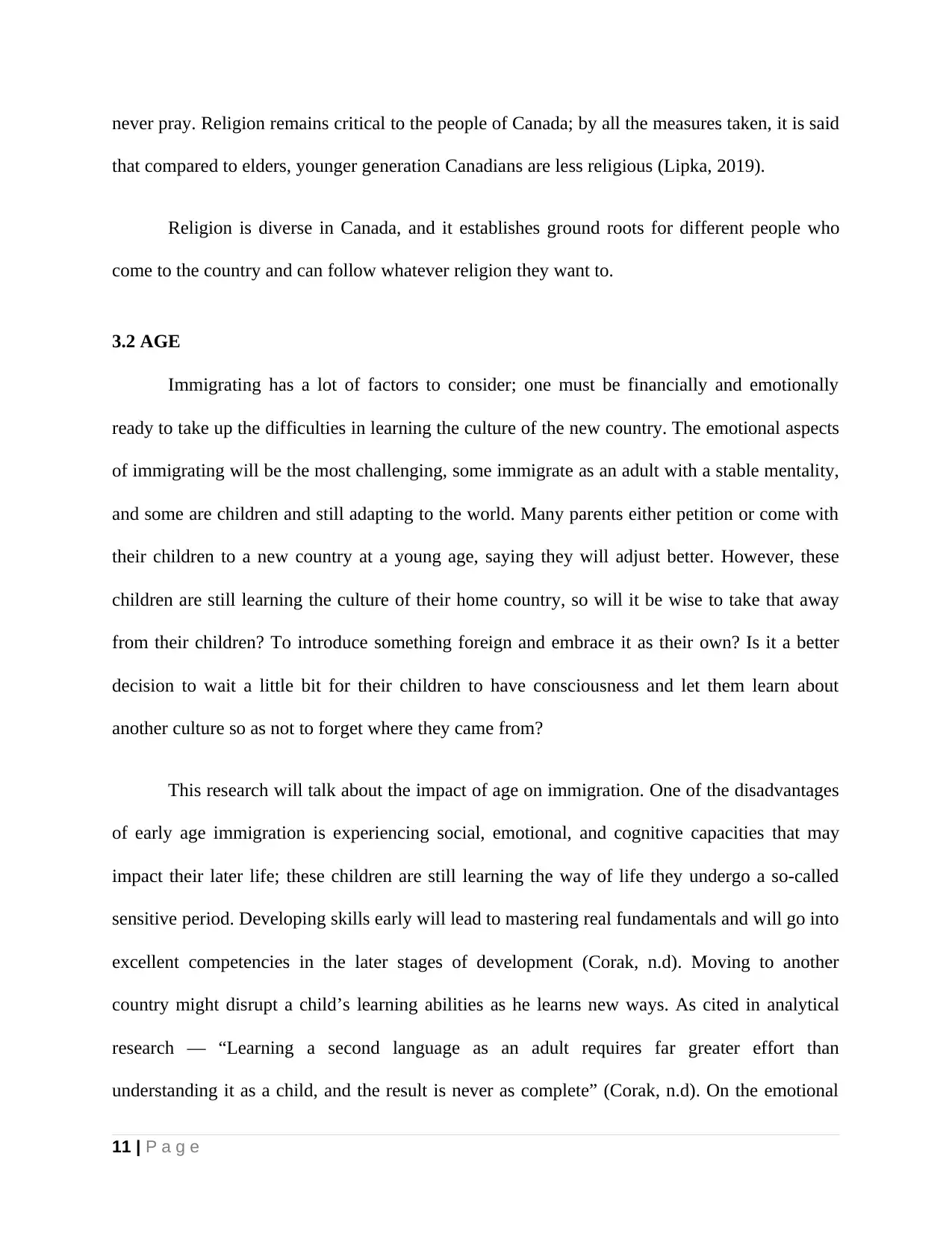
never pray. Religion remains critical to the people of Canada; by all the measures taken, it is said
that compared to elders, younger generation Canadians are less religious (Lipka, 2019).
Religion is diverse in Canada, and it establishes ground roots for different people who
come to the country and can follow whatever religion they want to.
3.2 AGE
Immigrating has a lot of factors to consider; one must be financially and emotionally
ready to take up the difficulties in learning the culture of the new country. The emotional aspects
of immigrating will be the most challenging, some immigrate as an adult with a stable mentality,
and some are children and still adapting to the world. Many parents either petition or come with
their children to a new country at a young age, saying they will adjust better. However, these
children are still learning the culture of their home country, so will it be wise to take that away
from their children? To introduce something foreign and embrace it as their own? Is it a better
decision to wait a little bit for their children to have consciousness and let them learn about
another culture so as not to forget where they came from?
This research will talk about the impact of age on immigration. One of the disadvantages
of early age immigration is experiencing social, emotional, and cognitive capacities that may
impact their later life; these children are still learning the way of life they undergo a so-called
sensitive period. Developing skills early will lead to mastering real fundamentals and will go into
excellent competencies in the later stages of development (Corak, n.d). Moving to another
country might disrupt a child’s learning abilities as he learns new ways. As cited in analytical
research ― “Learning a second language as an adult requires far greater effort than
understanding it as a child, and the result is never as complete” (Corak, n.d). On the emotional
11 | P a g e
that compared to elders, younger generation Canadians are less religious (Lipka, 2019).
Religion is diverse in Canada, and it establishes ground roots for different people who
come to the country and can follow whatever religion they want to.
3.2 AGE
Immigrating has a lot of factors to consider; one must be financially and emotionally
ready to take up the difficulties in learning the culture of the new country. The emotional aspects
of immigrating will be the most challenging, some immigrate as an adult with a stable mentality,
and some are children and still adapting to the world. Many parents either petition or come with
their children to a new country at a young age, saying they will adjust better. However, these
children are still learning the culture of their home country, so will it be wise to take that away
from their children? To introduce something foreign and embrace it as their own? Is it a better
decision to wait a little bit for their children to have consciousness and let them learn about
another culture so as not to forget where they came from?
This research will talk about the impact of age on immigration. One of the disadvantages
of early age immigration is experiencing social, emotional, and cognitive capacities that may
impact their later life; these children are still learning the way of life they undergo a so-called
sensitive period. Developing skills early will lead to mastering real fundamentals and will go into
excellent competencies in the later stages of development (Corak, n.d). Moving to another
country might disrupt a child’s learning abilities as he learns new ways. As cited in analytical
research ― “Learning a second language as an adult requires far greater effort than
understanding it as a child, and the result is never as complete” (Corak, n.d). On the emotional
11 | P a g e
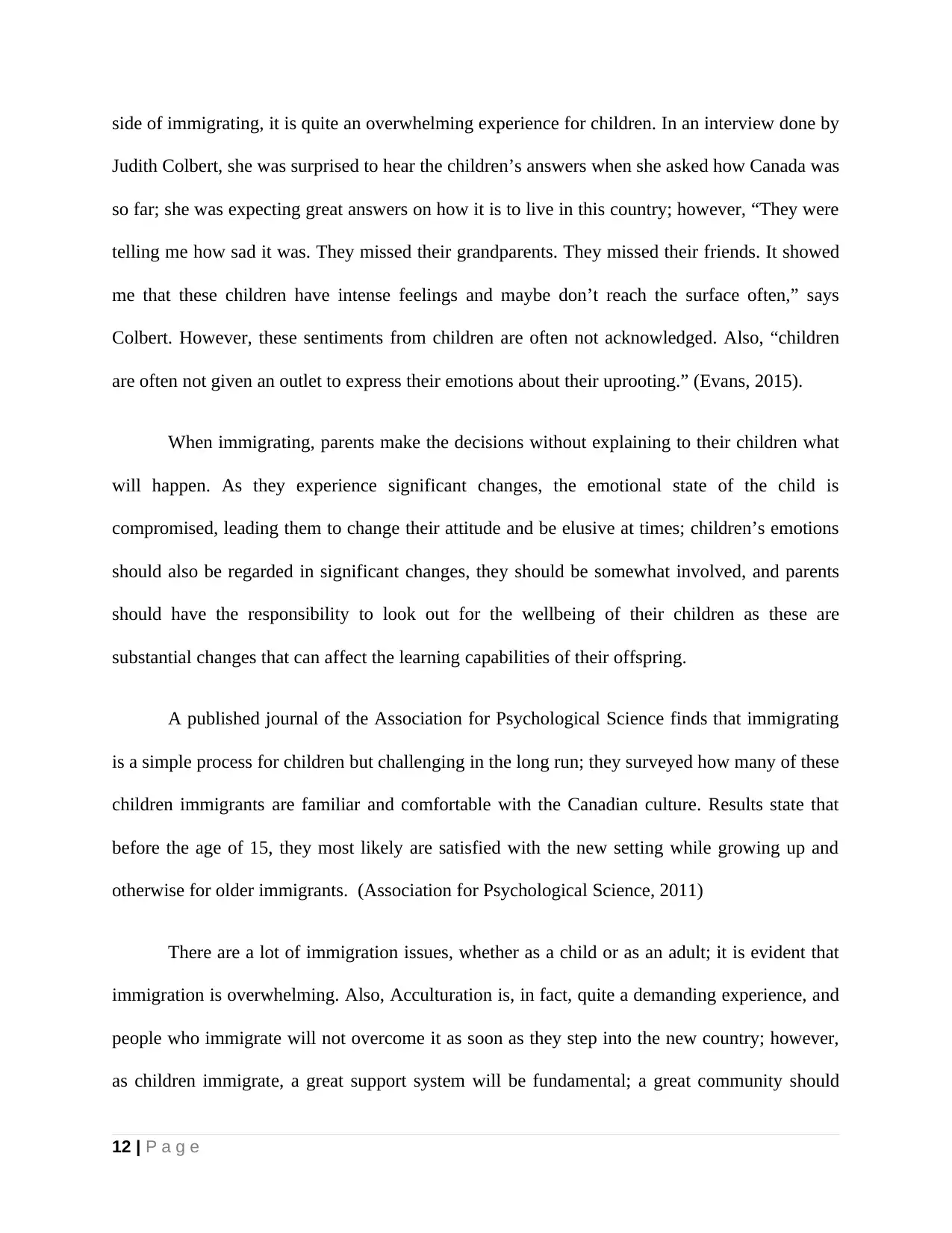
side of immigrating, it is quite an overwhelming experience for children. In an interview done by
Judith Colbert, she was surprised to hear the children’s answers when she asked how Canada was
so far; she was expecting great answers on how it is to live in this country; however, “They were
telling me how sad it was. They missed their grandparents. They missed their friends. It showed
me that these children have intense feelings and maybe don’t reach the surface often,” says
Colbert. However, these sentiments from children are often not acknowledged. Also, “children
are often not given an outlet to express their emotions about their uprooting.” (Evans, 2015).
When immigrating, parents make the decisions without explaining to their children what
will happen. As they experience significant changes, the emotional state of the child is
compromised, leading them to change their attitude and be elusive at times; children’s emotions
should also be regarded in significant changes, they should be somewhat involved, and parents
should have the responsibility to look out for the wellbeing of their children as these are
substantial changes that can affect the learning capabilities of their offspring.
A published journal of the Association for Psychological Science finds that immigrating
is a simple process for children but challenging in the long run; they surveyed how many of these
children immigrants are familiar and comfortable with the Canadian culture. Results state that
before the age of 15, they most likely are satisfied with the new setting while growing up and
otherwise for older immigrants. (Association for Psychological Science, 2011)
There are a lot of immigration issues, whether as a child or as an adult; it is evident that
immigration is overwhelming. Also, Acculturation is, in fact, quite a demanding experience, and
people who immigrate will not overcome it as soon as they step into the new country; however,
as children immigrate, a great support system will be fundamental; a great community should
12 | P a g e
Judith Colbert, she was surprised to hear the children’s answers when she asked how Canada was
so far; she was expecting great answers on how it is to live in this country; however, “They were
telling me how sad it was. They missed their grandparents. They missed their friends. It showed
me that these children have intense feelings and maybe don’t reach the surface often,” says
Colbert. However, these sentiments from children are often not acknowledged. Also, “children
are often not given an outlet to express their emotions about their uprooting.” (Evans, 2015).
When immigrating, parents make the decisions without explaining to their children what
will happen. As they experience significant changes, the emotional state of the child is
compromised, leading them to change their attitude and be elusive at times; children’s emotions
should also be regarded in significant changes, they should be somewhat involved, and parents
should have the responsibility to look out for the wellbeing of their children as these are
substantial changes that can affect the learning capabilities of their offspring.
A published journal of the Association for Psychological Science finds that immigrating
is a simple process for children but challenging in the long run; they surveyed how many of these
children immigrants are familiar and comfortable with the Canadian culture. Results state that
before the age of 15, they most likely are satisfied with the new setting while growing up and
otherwise for older immigrants. (Association for Psychological Science, 2011)
There are a lot of immigration issues, whether as a child or as an adult; it is evident that
immigration is overwhelming. Also, Acculturation is, in fact, quite a demanding experience, and
people who immigrate will not overcome it as soon as they step into the new country; however,
as children immigrate, a great support system will be fundamental; a great community should
12 | P a g e
⊘ This is a preview!⊘
Do you want full access?
Subscribe today to unlock all pages.

Trusted by 1+ million students worldwide
1 out of 20
Related Documents
Your All-in-One AI-Powered Toolkit for Academic Success.
+13062052269
info@desklib.com
Available 24*7 on WhatsApp / Email
![[object Object]](/_next/static/media/star-bottom.7253800d.svg)
Unlock your academic potential
Copyright © 2020–2025 A2Z Services. All Rights Reserved. Developed and managed by ZUCOL.





